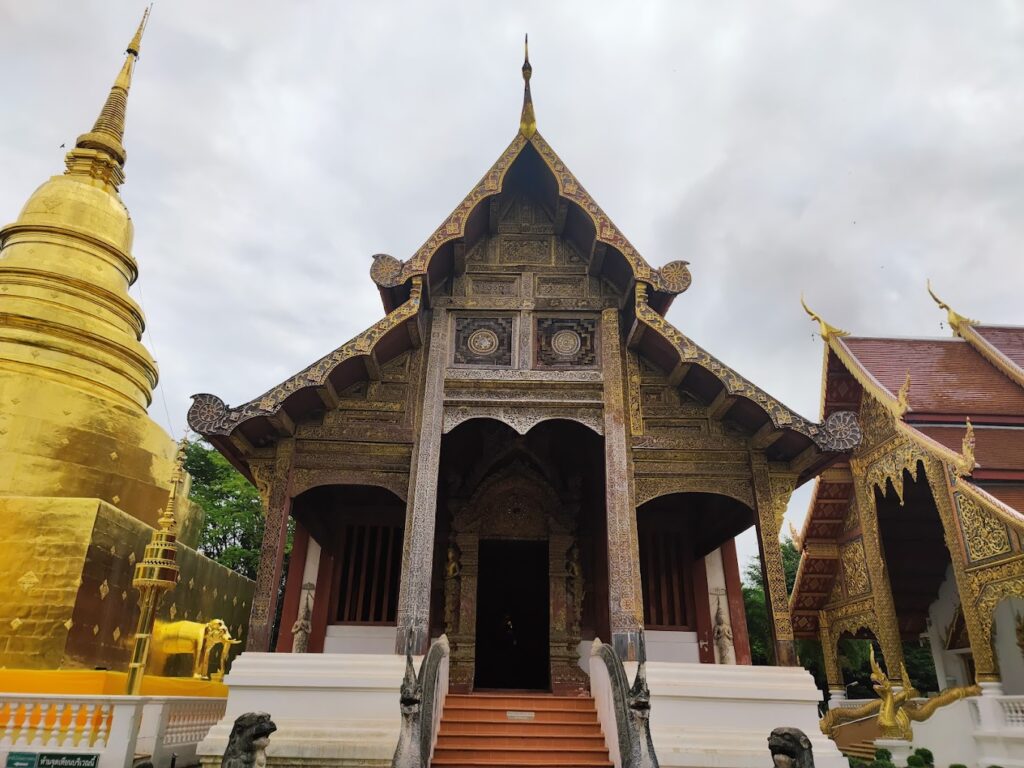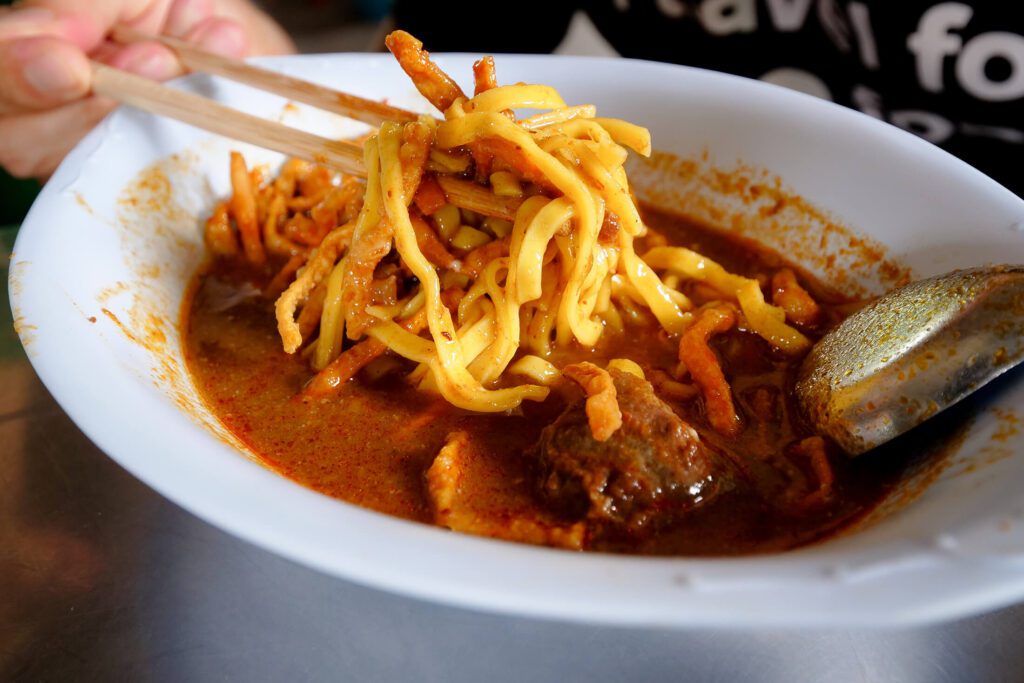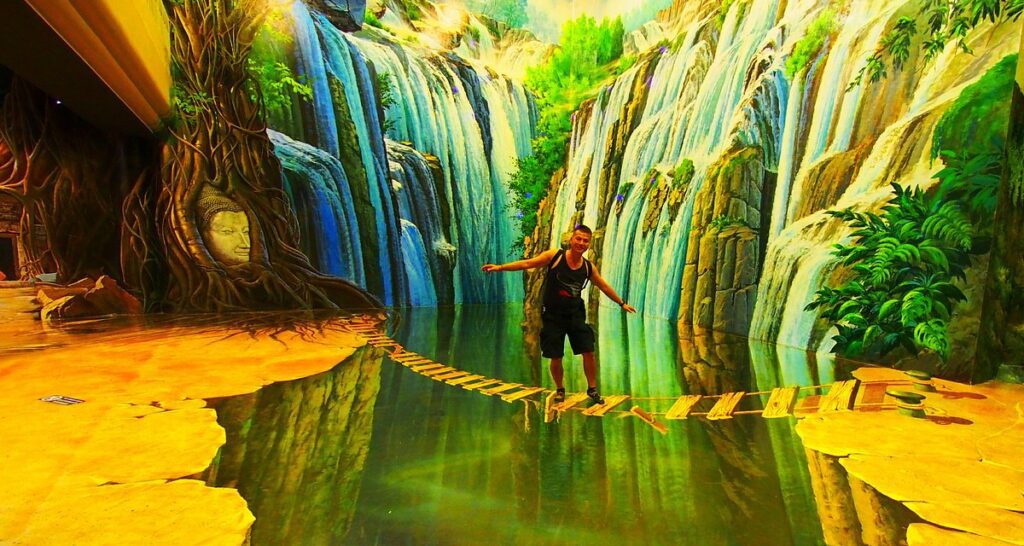Introduction to Chiang Mai’s Old City
Welcome to the enchanting world of Chiang Mai’s Old City, a place where the whispers of history mingle with the vibrant rhythms of modern life. This chapter offers an immersive journey into the heart of Chiang Mai, a city that has stood the test of time, preserving its heritage while embracing the new.
Overview of Chiang Mai’s Old City: Historical Significance and Charm
Nestled within ancient walls and moats, Chiang Mai’s Old City holds a treasure trove of history. Founded over 700 years ago, this area was once the capital of the Lanna Kingdom. Its streets are lined with temples that are architectural marvels, each telling a story of the city’s rich cultural and religious past. Here, the old and the new coexist harmoniously. Traditional wooden houses stand alongside contemporary cafes and shops, creating a charming blend of eras.
The historical significance of the Old City is palpable as you walk along its well-trodden paths. Key landmarks, such as the majestic Wat Phra Singh and the iconic Wat Chedi Luang, not only serve as spiritual centers but also as custodians of history, art, and architecture. These ancient temples, with their intricate carvings and serene monks, offer a window into the soul of the city.
What to Expect: A Blend of History, Culture, and Vibrant Street Life
Chiang Mai’s Old City is a living, breathing museum, where every corner has a story to tell. The cultural tapestry of the city is rich and diverse. Traditional art and crafts are displayed in small, family-run shops, while contemporary art galleries showcase the city’s evolving artistic expression.
The street life in the Old City is nothing short of vibrant. Markets such as the Sunday Walking Street transform the quiet lanes into bustling hubs of activity. Here, you can find everything from handcrafted souvenirs to local delicacies, all amidst the backdrop of live music and street performances.
Cuisine is an integral part of the Old City’s charm. From local eateries serving traditional Northern Thai dishes to trendy cafes offering international fare, the culinary landscape is as diverse as the city itself. The aromas of street food, the buzz of open-air markets, and the quiet of hidden courtyards create a sensory experience that is uniquely Chiang Mai.
Tips for Navigating the Old City: Transportation, Best Times to Visit, and Cultural Etiquette
Navigating the Old City is an adventure in itself. The most intimate way to explore is on foot, allowing you to soak in the details of this historic area. Alternatively, bicycles are available for rent, offering a leisurely way to traverse the narrow lanes. For longer distances, tuk-tuks and songthaews (shared taxis) are convenient options, though negotiating the fare beforehand is recommended.
Timing your visit can greatly enhance your experience. The cooler months from November to February offer pleasant weather, ideal for exploration. However, visiting during local festivals, such as Yi Peng and Songkran, provides a unique opportunity to witness the city in its full cultural splendor.
Understanding and respecting local customs is crucial. Dress modestly when visiting temples, and always remove your shoes before entering. Be mindful of your behavior in sacred spaces, and ask permission before taking photographs of monks or locals. Learning a few basic phrases in Thai can also go a long way in showing respect and enhancing your interaction with the locals.


Chapter 2: The Temples of the Old City
Chiang Mai’s Old City, a hub of spiritual and historical significance, is home to some of the most magnificent temples in Thailand. This chapter delves into the heart of these sacred spaces, exploring their rich histories, architectural beauty, and the enduring Buddhist traditions they uphold.
Wat Phra Singh: The Golden Temple and Its Rich History
Wat Phra Singh, often referred to as the ‘Golden Temple’, stands as a testament to the grandeur of Lanna architecture and Buddhist devotion. Founded in the 14th century, it houses the revered Phra Singh Buddha image, a symbol of spiritual significance for the local community.
The temple complex is a marvel of Lanna design, characterized by its intricately carved wooden structures, gilded umbrellas, and Naga serpents adorning the staircases. The main viharn (assembly hall) is an exquisite example of classical Lanna artistry, with its elaborate wood carvings and murals depicting the life of Buddha.
Wat Phra Singh is not just an architectural gem; it’s a living piece of history. It plays a central role in annual Buddhist festivals, including Songkran, where the Phra Singh Buddha image is paraded through the streets, allowing devotees to pay their respects and seek blessings.
Exploring Wat Chedi Luang: A Journey Through Time
Wat Chedi Luang, the ‘Temple of the Big Stupa’, offers a journey through time. Its massive chedi (pagoda), originally built in the 14th century, was once the tallest structure in ancient Chiang Mai. Although partially damaged by an earthquake in the 16th century, the temple remains a majestic sight, with its large elephant sculptures and intricate carvings.
The temple complex is also home to the city pillar (Lak Mueang), believed to house the city’s guardian spirits. This site is a focal point for local cultural and spiritual practices, with locals often seen offering prayers and incense.
Wat Chedi Luang is not just about its grandeur; it’s a place of learning and dialogue. The temple hosts monk chats, a unique opportunity for visitors to interact with Buddhist monks, learn about their way of life, and gain insights into Buddhist teachings.
Hidden Gems: Lesser-Known Temples with Unique Stories
Beyond the famous landmarks, the Old City is dotted with lesser-known temples, each with its own charm and story. Temples like Wat Jet Lin, with its tranquil pond and garden, offer a peaceful retreat from the city’s hustle. Wat Umong Suan Puthatham, outside the city walls, is known for its forest setting and ancient tunnel complex.
These hidden gems provide a glimpse into the daily spiritual life of the locals. They are places where tradition and tranquility are preserved, offering visitors a more intimate temple experience.
Understanding Lanna Architecture and Buddhist Traditions in Temples
The temples of the Old City are showcases of Lanna architecture, a style characterized by tiered roofs, elaborate wood carvings, and stucco decorations. This architectural style reflects the fusion of religious symbolism and local artistry, creating spaces that are both spiritual and aesthetically pleasing.
Understanding the Buddhist traditions in these temples adds depth to any visit. From the daily rituals of the monks to the significance of the temple layout, each element has a purpose and a story. Observing these practices, such as the giving of alms or the lighting of incense, provides insight into the Buddhist way of life and the spiritual heritage of the Lanna kingdom.


The Bustling Markets of Chiang Mai
Chiang Mai, known for its rich culture and history, is also famous for its vibrant markets. Each market in this city tells its own story, offering a unique blend of sights, sounds, and flavors. In this chapter, we’ll explore the bustling markets of Chiang Mai, from the traditional Warorot Market to the lively Night Bazaars, detailing the experiences they offer, tips on shopping, and the must-try foods that await you.
Warorot Market: A Local Experience Beyond Tourist Paths
Nestled in the heart of the city, Warorot Market (Kad Luang) is a treasure trove for those looking to dive into the local way of life. This market, a staple for Chiang Mai residents, offers an authentic glimpse into Northern Thai culture.
At Warorot, you can find a wide array of goods, from fresh produce and exotic spices to textiles and handicrafts. The market is a riot of colors and fragrances, with vendors selling everything from traditional Thai snacks to intricate handmade goods. It’s an ideal place to observe the daily routines of locals and to purchase unique souvenirs that are hard to find elsewhere.
Sunday Walking Street: Crafts, Food, and Culture
Every Sunday, the heart of the Old City transforms into the Sunday Walking Street, a lively stretch filled with artisanal crafts, mouth-watering street food, and live cultural performances. This market is a celebration of Northern Thai culture, showcasing local artisans and their crafts, including hand-painted umbrellas, wood carvings, and silver jewelry.
The food stalls at the Sunday Walking Street are a highlight, offering a chance to sample local delicacies like Khao Soi (curried noodle soup), Sai Oua (Northern Thai sausage), and an array of sweet treats. The street also features performances by local musicians and dancers, adding to the festive atmosphere.
Night Bazaars: A Blend of Traditional and Modern Shopping Experiences
As the sun sets, Chiang Mai’s Night Bazaars come alive. These markets, spread across different parts of the city, offer a more modern shopping experience. From the famous Chiang Mai Night Bazaar to the Anusarn Market, these bustling bazaars are a shopper’s paradise, with stalls selling everything from clothing and accessories to local art and souvenirs.
The Night Bazaars are not just about shopping; they are also culinary hotspots. With a variety of food stalls and open-air restaurants, visitors can indulge in Thai cuisine and international dishes. The vibrant atmosphere, illuminated by colorful lights and filled with the sounds of live music, makes for an unforgettable evening.
Tips on Bargaining, Local Crafts, and Must-Try Foods
Bargaining:
Bargaining is part of the shopping experience in Thai markets. Always approach it with a smile and a polite demeanor. Start by offering a price lower than what you’re willing to pay, and meet the seller halfway. Remember, it’s about finding a fair deal for both parties.
Local Crafts:
Chiang Mai is known for its skilled artisans. Look for unique crafts like handmade paper products, traditional Thai silk, and intricately carved woodwork. These items not only serve as beautiful souvenirs but also support local craftsmanship.
Must-Try Foods:
Your visit to Chiang Mai’s markets is incomplete without tasting the local cuisine. Don’t miss out on dishes like Pad Thai, Mango Sticky Rice, and fresh tropical fruits. For the adventurous, try local specialties like deep-fried insects!


Hidden Gems and Secret Spots in Chiang Mai
Chiang Mai, a city rich in culture and history, is filled with hidden gems and secret spots waiting to be discovered. Beyond its well-known attractions lies a world of lesser-seen wonders, each offering a unique glimpse into the city’s soul. This chapter invites you on a journey to explore these hidden treasures, from the ancient city walls to the enchanting alleyways of the Old City.
Exploring the City Walls and Gates: A Walk Through History
The ancient walls and gates of Chiang Mai, remnants of a bygone era, stand as silent witnesses to the city’s rich history. A walk along these historic ramparts is like stepping back in time. The four main gates – Thapae Gate, Chang Puak Gate, Suan Dok Gate, and Chiang Mai Gate – each have their own stories and significance.
Thapae Gate, the main entrance to the Old City, often hosts cultural events and is a popular gathering spot. A leisurely stroll along the walls offers a serene escape from the city’s bustle and a chance to admire the blend of ancient structures and lush greenery.
Lanna Folklife Museum: Understanding Northern Thai Culture
Tucked away in the heart of the Old City is the Lanna Folklife Museum, a treasure trove of northern Thai history and culture. Housed in a beautifully restored colonial building, the museum showcases the rich heritage of the Lanna Kingdom.
Through a collection of artifacts, photographs, and multimedia displays, visitors can learn about traditional Lanna lifestyles, arts, and crafts. The museum provides a deeper understanding of the local customs, beliefs, and the artistic legacy of the region, making it a must-visit for culture enthusiasts.
Art in Paradise: A Fun 3D Art Gallery Experience
For a playful and interactive experience, Art in Paradise, a 3D art gallery, offers a delightful escape. This gallery features an array of three-dimensional paintings that create optical illusions, allowing visitors to become part of the art.
The interactive exhibits, ranging from whimsical scenes to illusions of grandeur, provide endless fun for both adults and children. It’s a place where imagination comes to life, and visitors can capture memorable photos against the stunning backdrops.
Hidden Alleyways and Courtyards: The Lesser-Seen Side of the Old City
The charm of Chiang Mai’s Old City lies not just in its main attractions but also in its hidden alleyways and courtyards. Wandering off the beaten path, visitors can discover quaint coffee shops, local art studios, and serene gardens tucked away in unexpected corners.
These lesser-known spots offer a peaceful retreat from the tourist trails. They are where you can experience the everyday life of the locals, enjoy a quiet moment, and uncover the hidden beauty of Chiang Mai.


Cultural Immersion – Experiences and Etiquette in Chiang Mai
Chiang Mai, with its rich cultural tapestry, offers a multitude of experiences for those seeking a deeper connection with its traditions and ways of life. This chapter guides you through various avenues of cultural immersion in Chiang Mai, highlighting the importance of etiquette and sustainable tourism practices to ensure a respectful and enriching experience for both visitors and locals.
Participating in a Temple Stay or Meditation Retreat
For those seeking spiritual enrichment, participating in a temple stay or meditation retreat is a profound experience. Chiang Mai’s temples, such as Wat Phra That Doi Suthep or Wat Umong, offer programs where visitors can live alongside monks, partaking in daily rituals like alms giving and meditation sessions.
These retreats provide insight into Buddhist philosophy and practices. They are opportunities for self-reflection and understanding the significance of mindfulness in everyday life. Respect for the temple rules, dressing modestly, and engaging in activities with an open heart and mind are essential to make the most of this experience.
Traditional Lanna Dance and Music Performances
Experiencing traditional Lanna dance and music is a window into the artistic soul of Northern Thailand. The intricate movements of the dancers, the colorful costumes, and the hypnotic sounds of traditional instruments like the Khim (a type of hammered dulcimer) and the Ranat (a Thai xylophone) are mesmerizing.
Visitors can enjoy these performances at cultural centers, local festivals, or even in some of the temples. Joining in dance workshops or music classes can also be a fun way to immerse yourself in the local culture.
Etiquette and Cultural Norms: Respecting the Local Way of Life
Understanding and respecting local etiquette and cultural norms is vital for a respectful visit. Simple gestures like removing shoes before entering someone’s home or a temple, greeting with a Wai (a slight bow with palms pressed together), and being mindful of dress codes, especially in religious and sacred places, show respect for the local customs.
It’s also important to be considerate when taking photographs, particularly of people. Asking for permission is a sign of respect. Being aware of the local customs and traditions not only enriches your experience but also helps in building meaningful connections with the locals.
Sustainable Tourism: How to Visit Responsibly
Sustainable tourism is about making a positive impact on the environment, society, and economy of the places we visit. In Chiang Mai, this can mean choosing eco-friendly accommodations, supporting local businesses, and being mindful of your environmental footprint.
Engaging in community-based tourism, where you can learn from the locals about their way of life, helps in the equitable distribution of tourism benefits. It’s also crucial to be sensitive to over-tourism in popular spots, exploring off-beat paths to help reduce the strain on crowded areas.


Conclusion: Making Memories in Chiang Mai’s Old City
As our exploration of Chiang Mai’s Old City draws to a close, we reflect on the journey that has taken us through the vibrant tapestry of its history, culture, and hidden gems. This conclusion is not just an end, but an invitation to create your own unique memories in the heart of Northern Thailand.
Reflecting on the Journey Through Chiang Mai’s History and Culture
The journey through Chiang Mai’s Old City is a vivid mosaic of experiences – from the serenity of ancient temples to the lively hustle of night markets, and the rich cultural immersion in local traditions and customs. Each step through its alleyways, each interaction with its people, and each moment of quiet contemplation in its sacred spaces offers a deeper connection with the city’s soul.
Chiang Mai is a city where history is not just preserved in monuments but is a living part of everyday life. Its cultural vibrancy is seen in the daily rituals, festivals, and the warm smiles of its residents. The experiences you’ve had here – whether it’s participating in a meditation retreat, exploring the art scene, or savoring the local cuisine – are not just activities, but pathways to understanding and appreciating this unique city.
How to Create a Personalized Itinerary That Covers All Interests
Creating a personalized itinerary in Chiang Mai’s Old City involves balancing well-known attractions with off-the-beaten-path experiences. Start with the major historical sites and markets, then intersperse your schedule with visits to lesser-known temples or local workshops. Allocate time for spontaneous exploration – often, the most memorable experiences are the ones that are unplanned.
Consider your interests: Are you drawn to history, art, cuisine, or spiritual practices? Chiang Mai caters to all these and more. Engage in activities that resonate with you, whether it’s a cooking class, a bike tour around the city walls, or a traditional Lanna dance show. Remember to leave room in your schedule for rest and reflection, allowing you to fully absorb the richness of your experiences.
Encouraging Readers to Explore Beyond the Guide and Find Their Own Hidden Gems
While this guide has highlighted many of Chiang Mai’s treasures, the true essence of exploration lies in discovering your own hidden gems. Venture beyond the guidebook recommendations and let your curiosity lead the way. Talk to locals, explore side streets, and open yourself to the unexpected. Each corner of Chiang Mai has a story to tell, and sometimes the most unforgettable moments are found in the least expected places.
Chiang Mai is a city that rewards those who approach it with an open heart and a sense of adventure. Whether you’re wandering through its markets, learning about its traditions, or simply enjoying a quiet moment in a secluded courtyard, the memories you make here are yours to cherish.
Conclusion
Chiang Mai’s Old City is not just a destination; it’s an experience that stays with you long after you leave. It’s a place where history, culture, and modernity intertwine to create a unique tapestry that captivates and enchants. As you leave Chiang Mai, you take with you not just souvenirs, but stories, experiences, and a deeper understanding of a city that is truly special.








